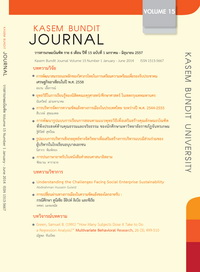การบริหารจัดการความขัดแย้งทางการเมืองในประเทศไทย ระหว่างปี พ.ศ. 2544 – 2555
Keywords:
การจัดการความขัดแย้ง, ความไม่สงบทางการเมือง, รัฐประหาร, conflict management, political conflict, coup d’ é tatAbstract
การศึกษานี้ มีวัตถุประสงค์ดังนี้ 1) เพื่อศึกษาการก่อตัวของความขัดแย้งทางการเมืองในประเทศไทยระหว่างปี พ.ศ. 2544-2555 2) เพื่อศึกษารูปแบบความขัดแย้งทางการเมืองในประเทศไทยระหว่างปี พ.ศ. 2544-2555 3) เพื่อศึกษาผลกระทบต่อความมั่นคง ประชาชน และประชาธิปไตย ที่เกิดจากความขัดแย้งทางการเมืองในประเทศไทยระหว่างปี พ.ศ. 2544-2555 และ 4) เพื่อศึกษาการบริหารจัดการความขัดแย้งทางการเมืองในประเทศไทยระหว่างปี พ.ศ. 2544-2555
วิธีวิจัยใช้วิธีการสัมภาษณ์เชิงลึกผู้ให้ข้อมูลสำคัญโดยวิธีเฉพาะเจาะจง จากนักการเมือง นักธุรกิจ นักวิชาการ สื่อมวลชน ข้าราชการ จำนวน 30 คน เก็บข้อมูลโดยใช้แบบสอบถามจากกลุ่มตัวอย่างประชาชนในเขตกรุงเทพมหานครและปริมณฑล จำนวน 600 คน เลือกแบบเจาะจง
ผลการวิจัยพบว่า
การก่อตัวของความขัดแย้งทางการเมืองในประเทศไทยระหว่างปี พ.ศ. 2544-2555 สาเหตุที่ทำให้เกิดความขัดแย้ง ประกอบด้วย ความเหลื่อมล้ำทางเศรษฐกิจ สังคมและการเมืองของประชาชน การขัดกันในอำนาจและผลประโยชน์ของกลุ่มการเมือง สื่อมวลชนและกลุ่มพันธมิตร การรัฐประหาร ระบบตรวจสอบถ่วงดุล รัฐธรรมนูญปี 2540 รัฐธรรมนูญปี 2550 การก่อตัวความขัดแย้งเป็นมูลเหตุที่สำคัญที่สุดคือ การชุมนุมทางการเมืองโดยยึดสถานที่สาธารณะ ( = 3.02, S.D. = .931)
รูปแบบความขัดแย้งทางการเมืองในประเทศไทยระหว่างปี พ.ศ. 2544-2555 ประกอบด้วย สื่อมวลชนที่ไม่เป็นกลางและนำเสนอข้อมูลไม่ครบถ้วน นักวิชาการที่ไม่เป็นกลาง วาทกรรม “อำมาตย์และไพร่” การชุมนุมของกลุ่มคนเสื้อเหลือง การปราบปรามและการใช้กำลังโดยรัฐ และการบังคับใช้กฎหมายอย่างไม่เป็นธรรมและไม่เท่าเทียมกัน รูปแบบความขัดแย้งที่มีระดับปัญหาสูงสุดคือ การชุมนุมปราศรัยที่แยกราชประสงค์ ( = 3.20, S.D. = .868)
ผลกระทบต่อความมั่นคง ประชาชน และประชาธิปไตย ที่เกิดจากความขัดแย้งทางการเมืองในประเทศไทยระหว่างปี พ.ศ. 2544-2555 ประกอบด้วย ผลกระทบทางด้านความแตกแยกของคนในชาติ จริยธรรมและธรรมาภิบาล ผลกระทบด้านความมั่นคง ผลกระทบด้านเศรษฐกิจ การยอมรับของประเทศในระดับนานาชาติ ผลกระทบกับความเชื่อมั่นในกระบวนการยุติธรรม ประชาธิปไตย ผลกระทบที่มากที่สุดคือ ผลกระทบด้านเศรษฐกิจ ( = 3.53, S.D. = .710)
การบริหารจัดการความขัดแย้งทางการเมืองในประเทศไทยระหว่างปี พ.ศ. 2544-2555 ประกอบด้วย การสร้างความสามัคคีของคนในชาติ การแก้ปัญหาโดยสันติวิธีและการใช้กระบวนการตามระบอบประชาธิปไตย การเยียวยา การปรองดอง การให้ความเป็นธรรมตามกฎหมาย การอภัยโทษในกรอบกฎหมาย โดยสังเคราะห์เป็นตัวแบบในการบริหารจัดการความขัดแย้งประกอบด้วย 1) กระบวนการปรองดองที่มีรัฐบาลเป็นผู้นำ (reconciliation process led by government) 2) การสร้างอนาคตร่วม (shared future) 3) การแบ่งปันอำนาจ (shared power) 4) การจัดสรรผลประโยชน์ (shared benefits) ผลวิจัยเชิงปริมาณพบว่า ปัจจัยที่จะแก้ไขความขัดแย้งได้สูงที่สุดคือ การสร้างความสามัคคีของคนในชาติ ( = 3.43, S.D. = .767)
The objectives of this research were to study: 1) The formulation of political conflict in Thailand during the years 2001 – 2012; 2) The forms of political conflict in Thailand during the years 2001 – 2012; 3) The impact on security, citizens, and democracy due to political conflict in Thailand during the years 2001 – 2012; and 4) Political conflict management in Thailand during the years 2001 – 2012.
An in-depth interview was conducted for 30 key informants, selected by a purposive sampling from politicians, academicians, government officials, and media and business persons. A sample survey was conducted to collect data from 600 respondents living in Bangkok and its vicinity.
Findings were as follows: The formulation of political conflict in Thailand during the years 2001–2012 was due to the unbalance of social, economic and political factors among the citizens, the conflict of power and interests among political groups, the media and the democratic alliance group, the coup d’ é tat, independent entities, and the constitutions of the years 1997 and 2007. The most influential factor was the political protest by occupying public areas ( = 3.02, S.D. = .931)
The forms of political conflict in Thailand during the years 2001 – 2012 were the bias of the media and academics, the discourse of “Lords and commons,” the protest of the “yellow shirt” and “red shirt” groups, force used by government, and ineffective law enforcement. The most influential factor was the political protest in the Rajprasong Area ( = 3.20, S.D. = .868)
The impacts on security, citizens, and democracy from the political conflict were disharmony, ethical and good governance, security, economic impact, the acceptance of the country in international communities, and the confidence in the justice system. The most influential factor was the economic impact ( = 3.53, S.D. = .710)
Political conflict management in Thailand during the years 2001 – 2012 consisted of building national unity with the democratic process, remedies, equality of the justice, and forgiveness. The model could be synthesized with the model of conflict and reconciliation management or the 3S reconciliation model comprised of: 1) Reconciliation process led by government; 2) Shared future; 3) Shared power; and 4) Shared benefits. The most influential factor was building the national unity ( = 3.43, S.D. = .767)
Downloads
How to Cite
Issue
Section
License
ทัศนคติ ความคิดเห็นใด ๆ ที่ปรากฏในวารสารเกษมบัณฑิตฉบับนี้เป็นของผู้เขียน โดยเฉพาะ มหาวิทยาลัยเกษมบัณฑิตและบรรณาธิการ ไม่จำเป็นต้องมีความเห็นพ้องด้วย







